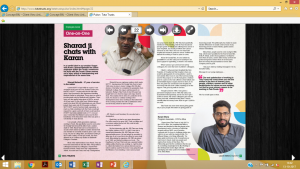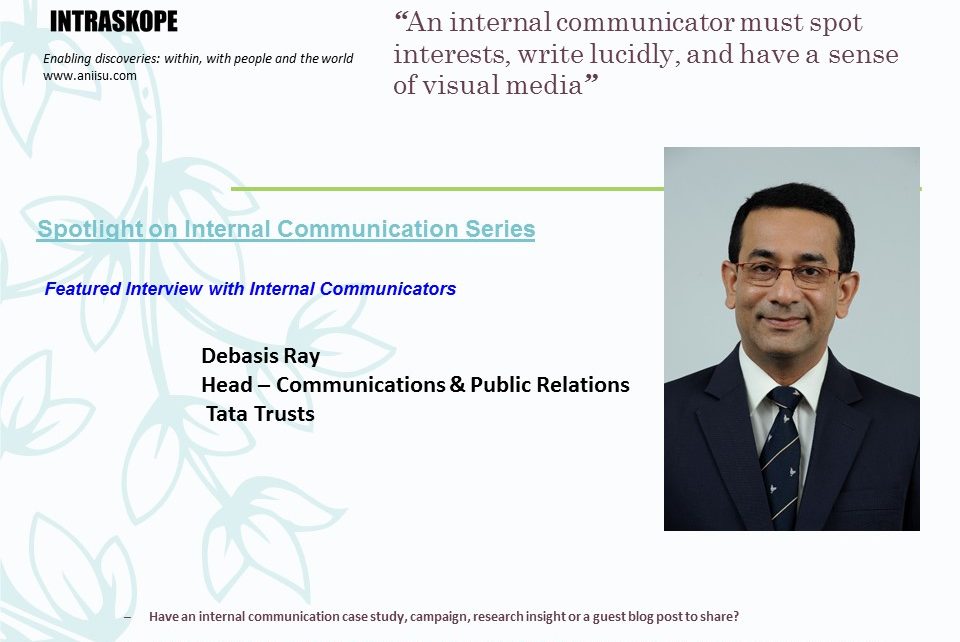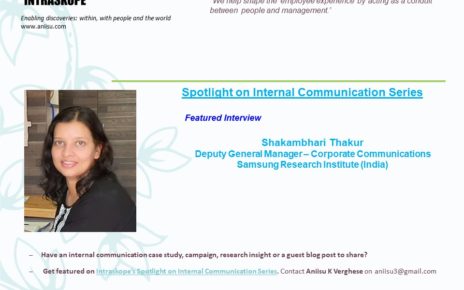You can also now subscribe to my YouTube Channel for more updates.
How can internal communicators appeal to employees’ hearts and not just their minds? What can they do to personally lead by example?
Helping employees buy into the organization’s purpose is a fundamental role of the internal communicator, feels Debasis Ray, Head – Communications & Public Relations – Tata Trusts.
Read his interview in the 9th edition of Intraskope’s Spotlight on Internal Communication Series.
Debasis is an advocate of storytelling and using technology to enable internal communications. Do read on and share your thoughts.
Interview
What does internal communication mean to you?
The goals to me, in internal communications, are to keep colleagues positively engaged with the organization’s purpose, and to provide them access to content which is relevant to their jobs and lives. To do this, we need to share how the organization is fulfilling its goals, create platforms for colleagues to connect with each other, and to celebrate individuals’ contributions to the organisation.
How is it practiced in your organization?
We have historically been a small organization, which in the last couple of years has somewhat expanded. So, besides face-to-face and congregational interactions, the need of internal communication tools is also gaining momentum. We are doing it both through traditional means, as well as social media tools. Very recently, we have introduced Workplace by Facebook and have also begun an internal magazine. These are cross-functional responsibilities, and not solely by the communications team.

Please share an example/campaign that you are personally proud of working on and that made a significant impact to your organization.
My personal example is from a previous organization. I started this in 2005 and ran it till I was in the organisation. My hypothesis was that colleagues needed to know what was happening in the wider industry and economy, but not everybody had access to every media; so why not create a weekly bulletin, with links to the source? We called it ‘News this Week’, and would send it out religiously every Friday evening. If I remember correctly at the end of the fifth year, a colleague wrote in to congratulate the team to say that he had unfailingly received it every Friday for the last few years. It told me that a simple initiative often has immense value.
What is the biggest challenge you face while going about managing internal communication?
The biggest challenge is a continuous flow of content, and presenting content such that it can capture attention. Perhaps, an additional challenge is reducing attention span.
The way to go about surmounting the content challenge is networking inside the organization. When it comes to the content presentation challenge, it is good to take guidance from the youngest staff. They are digital natives, and help create solutions with impact.
What according to you is the biggest opportunity that internal communicators have?
The prime need is a constant flow of meaningful content.
Internal communicators have the advantage that they have wide access in the organization. As long as communicators have the nose for what is of relevance, they have a large playing field.
The second opportunity is the assistance of technology. All the technology-based platforms can be tailored for internal use. Secondly, technology has made it so much easier to deploy audio-visuals. In our organization, we have begun to make use of these opportunities.
For example, say a workshop has been held. The workshop’s reports and presentation, when communicated, can also include a short clip capturing the presenters. All it requires is a smart phone and an editing software.
How can internal communicators add more value to the business?
Making the organization emotionally come alive is very important. Our fondest memories of organizations are those that appeal to our hearts. Communicators can best add value by becoming chroniclers for the organisation so that their story-telling creates that emotional connect.
For example, in an earlier organization, when we were celebrating its 75th year, we found that while we had a glorious presence in the country, we hardly had a narrative of our rich past. That meant travelling across the country for months engaging with retired managers and desk research to come up with an anecdotal narrative of the organization. I now see it in the organization’s website suitably updated.
For example, we heard a retired manager tell us that decades back the visiting global chairman was addressing managers. A young manager asked what it took to become chairman. The chairman smiled, thanked the youngster for thinking so far ahead, and then said — what it took was competence, contribution and character, the last taking precedence over the first two.
Stories, like these, are fundamental to an organisation and need to be retold, from generation to generation. When done well, they become the organization’s chronicle.
In a later organisation, I introduced a section on seniors recollecting the organization when they had joined, and the transformation they see. That made organization story-telling more continuous.
Technology platforms today allow chronicling to be kept contemporary, almost as a living document, and easily accessible.
What is your advice for people who are keen to join internal communication and make a career? What skills must they have or develop?
I believe the fundamental competency is to act like an intra-organisation journalist. I have an audience: What is of interest to that audience, in their work and personal lives? How best can I capture their eyeballs?
If this has to be achieved, an internal communicator must personally have three essential abilities: to spot interests, write lucidly, and have a sense of visual media. When one has these qualities, it has as much an impact than a 140-character tweet or a 1400-word report. The added advantage these personal qualities bring is better command over external entities one uses.
There is no alternative to personally being able to create magic with words and visuals.
Missed previous stories from organizations featured on the Intraskope’s Spotlight on Internal Communication Series? Look them up here – Infosys, SOBHA Ltd., ICICI Securities, First Advantage, CK Birla Group, TVS Motors, GE and Suzlon.
Intraskope (www.aniisu.com) is the first blog on internal communications in India and among the earliest around the globe. Begun in 2006, the blog has over 520 posts on topics such as employee engagement, leadership communication and employee branding and receives thousands of visits from across the world. The blog offers learning resources for practitioners, academicians, and students including industry workshops, research reports, and checklists. Intraskope has been featured on leading global internal communication forums like Simply-Communicate, IC Kollectif and International Association of Business Communicators. It is hosted by Aniisu K Verghese, author of Internal Communications – Insights, Practices & Models (Sage, 2012).
If you are an internal communication practitioner working in a firm or a not-for-profit and have an internal communication case study, campaign, research insight or a guest blog post to share please contact me on [email protected]



Thank you for the insights Debasis. Do you have any recommendations on how we can get employees to contribute content and blog posts? This is a challenge that I face regularly, especially with the techies.
Yes, this indeed is a challenge. Perhaps, this arises from a sense of diffidence in all of us from what to post on.
I have noticed that when editors allow a wide degree of freedom, contributions begin to come in ones and twos. Finally, common interest areas begin to get formed.
For example, in a previous organisation, when we began an intranet we had a corner, where colleagues could contribute on any topic – from personal interest areas to work related topics. And, we indeed began to see colleagues contributing with even creative writing. During the five years I was there, I recall only one instance when a post had to be declined.
So, if you are not already doing so, why not open it up to any type of contribution – including videos and photographs – than specifically seeking certain type of content in pre-decided formats?
Perhaps, it will lead to greater regularity.